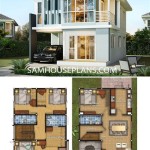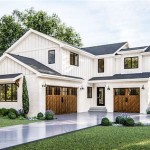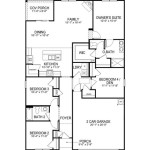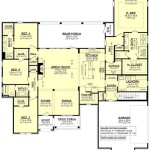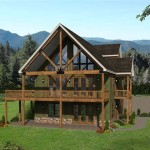Handicap Accessible Home Floor Plans: Designing for Inclusive Living
Designing a home that is accessible to individuals with disabilities requires careful consideration of spatial layout, maneuverability, and safety features. Handicap accessible home floor plans prioritize inclusivity, enabling residents with mobility limitations, visual impairments, or other physical challenges to navigate their living spaces independently and comfortably. These plans go beyond mere compliance with accessibility standards; they aim to create a supportive and empowering environment that enhances quality of life.
Creating an accessible home starts with understanding the needs of the occupants. This involves considering the specific types of disabilities, the level of assistance required, and the individual preferences of the residents. Gathering this information allows architects and designers to tailor the floor plan to optimize functionality and comfort.
Key Considerations in Designing Accessible Floor Plans
Several core principles guide the design of handicap accessible home floor plans. These principles encompass spatial requirements, adaptable features, and safety measures that ensure seamless navigation and independent living. By focusing on these areas, designers can create homes that are both functional and aesthetically pleasing, catering to a diverse range of needs.
Spatial Requirements and Maneuverability: Adequate space is fundamental in accessible design. Doorways should be widened to a minimum of 32 inches clear width to accommodate wheelchairs, walkers, and other mobility aids. Hallways need to be at least 36 inches wide to facilitate easy passage. Furthermore, turning radii within rooms, particularly in bathrooms and kitchens, must be sufficient to allow wheelchair users to maneuver comfortably, typically requiring a 5-foot turning circle.
Open floor plans are often preferred in accessible design as they minimize the need for tight turns and narrow passages. By reducing the number of walls and creating interconnected spaces, residents can move freely between rooms. This design approach also promotes a sense of spaciousness and reduces the feeling of confinement, contributing to a more welcoming and comfortable living environment.
Adaptable Features and Universal Design Elements: Adaptable features enable the home to evolve with the changing needs of the residents. Examples include adjustable-height countertops and sinks in the kitchen and bathroom, allowing individuals of varying heights to use these spaces comfortably. Similarly, installing grab bars in bathrooms provides added support and stability, reducing the risk of falls.
Lever-style door handles are easier to operate than traditional knobs, particularly for individuals with limited hand strength or dexterity. Rocker-style light switches are also more accessible than toggle switches. These seemingly small details can significantly enhance the usability of the home for individuals with disabilities.
Universal design principles focus on creating products and environments that are usable by all people, to the greatest extent possible, without the need for adaptation or specialized design. This approach integrates accessibility seamlessly into the design process, rather than treating it as an afterthought. Universal design elements benefit not only individuals with disabilities but also elderly residents, children, and anyone with temporary mobility limitations.
Safety Measures and Emergency Preparedness: Safety is paramount in accessible home design. Slip-resistant flooring should be used throughout the home, especially in areas prone to moisture, such as bathrooms and kitchens. Contrasting colors can be used to highlight edges and transitions, improving visibility for individuals with visual impairments.
Smoke detectors and carbon monoxide detectors should be installed on each level of the home, and they should be equipped with strobe lights in addition to audible alarms to alert individuals with hearing impairments. Emergency exits should be clearly marked and easily accessible. Consider installing a home automation system that allows residents to control lights, temperature, and door locks remotely, enhancing security and convenience.
Furthermore, it is crucial to develop an emergency preparedness plan that addresses the specific needs of the residents. This plan should outline evacuation procedures, communication strategies, and necessary assistive devices. Regular drills can help ensure that everyone is familiar with the plan and prepared to respond effectively in an emergency.
Designing Accessible Bathrooms and Kitchens
Bathrooms and kitchens require particular attention in accessible home design, as these spaces often present significant challenges for individuals with disabilities. Careful planning is essential to ensure that these areas are safe, functional, and comfortable.
Accessible Bathroom Design: In an accessible bathroom, a roll-in shower with a grab bar and adjustable showerhead is preferable to a traditional tub. A bench or seat within the shower provides additional support and comfort. The shower floor should be level with the surrounding floor to eliminate tripping hazards. A handheld showerhead with a long hose offers flexibility and convenience.
The toilet should be installed at a height that is comfortable for wheelchair users to transfer to and from. Grab bars should be installed on both sides of the toilet to provide support and stability. A wall-mounted sink with knee clearance allows wheelchair users to roll underneath the sink comfortably. The mirror should be positioned at a height that is accessible to individuals seated or standing.
Accessible Kitchen Design: An accessible kitchen features adaptable countertops and sinks that can be adjusted to suit the needs of different users. A side-by-side refrigerator with pull-out shelves makes it easier to access food items. A front-control stove with clear markings ensures safe and easy operation.
Ample knee clearance should be provided under the sink and cooktop to allow wheelchair users to work comfortably. Pull-down shelves in upper cabinets make it easier to reach items stored on higher shelves. A dishwasher with a front control panel and pull-out racks simplifies loading and unloading. A clear and unobstructed pathway throughout the kitchen promotes safe and efficient movement.
Proper lighting is essential in an accessible kitchen. Under-cabinet lighting illuminates work surfaces, while recessed lighting provides general illumination. Task lighting should be positioned to minimize glare and shadows, enhancing visibility for individuals with visual impairments.
Implementing Assistive Technology and Home Automation
Assistive technology and home automation systems can significantly enhance the independence and quality of life for individuals with disabilities. These technologies can automate tasks, improve communication, and enhance safety and security.
Assistive Technology Solutions: Voice-activated control systems allow residents to operate lights, appliances, and other devices using voice commands. This technology is particularly beneficial for individuals with limited mobility or dexterity. Adaptive switches can be customized to respond to a variety of movements, such as blinking or head nods, enabling individuals with severe physical limitations to control their environment.
Personal emergency response systems (PERS) provide a means for residents to summon help in the event of a fall or other emergency. These systems typically consist of a wearable pendant or wristband that, when activated, sends a signal to a monitoring center. The center can then dispatch emergency services or contact designated caregivers.
Home Automation Systems: Smart home technology can automate various functions, such as lighting control, temperature regulation, and door locking. This technology can be controlled remotely using a smartphone, tablet, or voice assistant. Automated lighting systems can be programmed to turn on and off at predetermined times, enhancing security and energy efficiency. Smart thermostats can be programmed to maintain a comfortable temperature, reducing the risk of overheating or hypothermia.
Automated door locks can be controlled remotely, allowing residents to grant access to visitors or caregivers without having to physically open the door. Security cameras and motion sensors provide added security and peace of mind. These systems can be integrated to provide a comprehensive home automation solution that enhances independence, safety, and convenience.
Designing handicap accessible home floor plans is an ongoing process that requires continuous learning and adaptation. By staying informed about the latest accessibility standards, technologies, and design trends, architects and designers can create homes that are not only functional and safe but also aesthetically pleasing and empowering.
These accessible designs should also consider the needs of caregivers who might be assisting residents. Adequate space for maneuvering alongside the resident is important, as is having easily accessible storage for any necessary medical equipment or supplies. It is important to remember that creating a truly accessible home is a collaborative effort between the designer, the resident, and their caregivers.

Plan 8423jh Handicapped Accessible Split Bedroom Southern House Plans Floor

Wheelchair Accessible House Plan 2 Bedrms Baths 1687 Sq Ft 147 1009

Wheelchair Accessible Small House Plans Drummond

Wheelchair Accessible Floor Plan House Plans Bathroom

Wheelchair Accessible Small House Plans Drummond

798 Sq Ft Wheelchair Accessible Small House Plans Tiny

How To Make Your Home Wheelchair Accessible

How To Make Your Home Wheelchair Accessible

Home And Garden Wheelchair Accessible House Plans

Wheelchair Accessible Small House Plans Drummond


